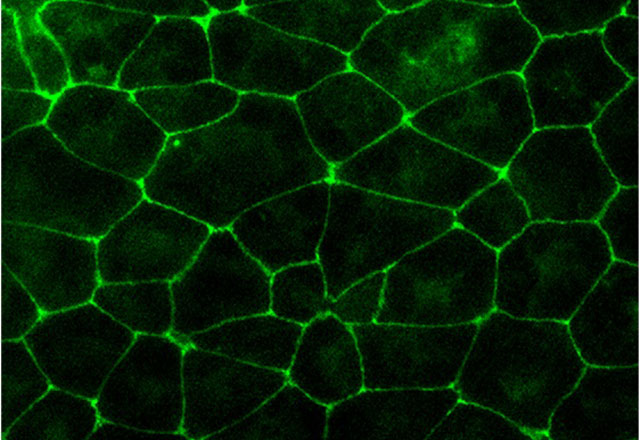Stem Cell Solutions for Corneal Transplants
Amer Riazuddin’s research is at the forefront of regenerative medicine.

Amer Riazuddin, Ph.D.
Most people know the cornea is the outermost tissue of the eye — the part that you touch when you put in contact lenses. What people may not know is that the cornea has five layers, the innermost of which is the endothelium. When the function of the corneal endothelium is compromised either due to disease or trauma, the cornea loses its transparency, which results in vision loss.
Transplant surgery using human donor tissue is the only treatment available for corneal endothelial dysfunction. Unfortunately, corneal transplants using donor corneas are expensive and, owing to the shortage of transplantablegrade corneal tissue, are out of reach for many people, particularly those in underresourced nations.
Wilmer’s Amer Riazuddin, Ph.D., a rising star in ocular regenerative medicine, is focused on developing stem cell solutions to improve outcomes for people around the world who need these transplants.
One reason for the shortage of transplantable-grade corneal tissue in many parts of the world is the lack of eye banking. As an example, Riazuddin cites China, the world’s most populous country, where there is neither a national eye bank association nor eye bank union, according to a report in the journal PLoS ONE in 2020. “Most, if not all, of the donor tissue for transplant surgeries in China comes from the eye banks of America,” he says.
Riazuddin’s team has found a way to increase the supply of the cells needed to treat corneal endothelial dysfunction. They take pluripotent stem cells, which have the potential to differentiate into most cell types of the human body, as the beginning material and differentiate them into corneal endothelial cells.

Pluripotent stem cell-derived corneal endothelial cells stained (green) for Zonula occludens-1 (ZO-1: a protein present in the endothelial cells) to visualize the hexagonal/polygonal morphology of corneal endothelial cells under a microscope.
Image credit: Ali et al., Pluripotent stem cell-derived corneal endothelial cells as an alternative to donor corneal endothelium in keratoplasty, Stem Cell Reports (2021), https://doi.org/10.1016/j.stemcr.2021.07.008
In tests using preclinical models, the results of which were published in the journal Stem Cell Reports in 2021, Riazuddin’s laboratory confirmed that settlement of the cells on the back of the cornea leads to the regeneration of a functional corneal endothelium and the restoration of the corneal transparency essential for optimal vision.
The overall goal of Riazuddin’s team is to make these cells accessible to patients around the globe. The shelf life and stability of the cells during shipment are critical to achieving this goal. Riazuddin’s laboratory has validated a 40-day shelf life for the cells, which compares favorably to the two-week shelf life of donor tissue. Additionally, the laboratory has examined the stability of these pluripotent stem cells during shipment.
“The results of this ongoing study are very promising,” says Riazuddin. Both of these features will facilitate a commercialization process for the treatment should the FDA approve it. Riazuddin is in the midst of applying for FDA approval.
To support this innovative research, Riazuddin was named Wilmer’s newest Boone Pickens Professor of Ophthalmology in November 2023. Riazuddin’s research and goal of commercializing stem cells led to his receiving a unique endowed professorship partially funded by philanthropy and partially by the state of Maryland. The Maryland E-Nnovation Initiative Fund, administered by the Maryland Department of Commerce, offers a state match to private funds raised in support of endowed chairs at Maryland’s higher education institutions. The purpose is to retain top university researchers within Maryland and encourage collaboration with a focus on entrepreneurial activity.
The philanthropy comes from T. Boone Pickens, the late Texas entrepreneur and philanthropist. With a $20 million bequest from the T. Boone Pickens Foundation, Wilmer has created several endowed professorships in Pickens’ name. “Because Mr. Pickens was educated as a scientist, as a geochemist and became a successful businessman himself, I think he would be delighted to see that Dr. Riazuddin is learning how to translate science into business,” says Wilmer Director Peter J. McDonnell, M.D., the William Holland Wilmer Professor of Ophthalmology.
Speaking on behalf of Mr. Pickens’ family and friends, Pickens’ daughter Liz Cordia told the audience at the professorship dedication that her father would be delighted to see the impact of his gift on the exciting research of young faculty like Dr. Riazzudin.
As Riazuddin pursues translating his research into a treatment with commercial potential, he has his eyes on a very specific prize: reducing preventable vision loss around the globe. “This is what makes me get up in the morning,” says Riazuddin.
